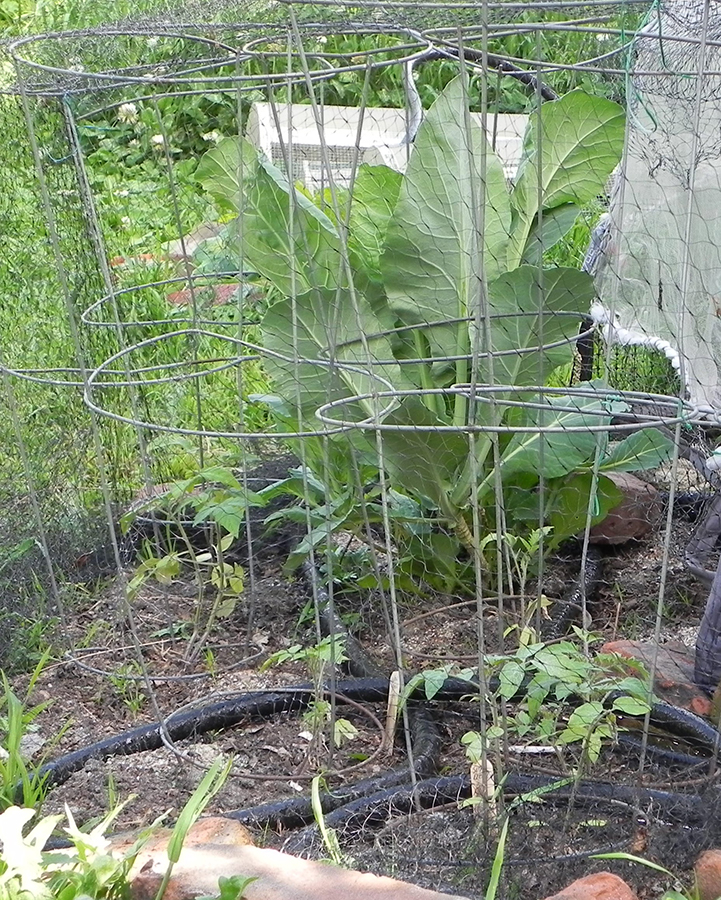by Margie Siegal
“Well, we all need someone we can lean on
And if you want it, you can lean on me
Yeah, we all need someone we can lean on
And if you want it, you can lean on me”
–The Rolling Stones, Let it Bleed
Some of our favorite fruits and vegetables started out as vines – think kiwis, grapes, peas and beans. While bush varieties of some of these edibles have been developed, the backyard grower with limited horizontal but plenty of vertical space gravitates towards the older varieties, which will grow tall and produce more per plant, making the most of what room there is. Heirloom varieties that climb also often taste better than the newer hybrids.
Other plants – like tomatoes and squash – sprawl on the ground, leaving themselves open to attack by ground dwelling bugs and slugs. Staking up your plants keeps them out of harm’s way.
In the ten thousand years that humans have been engaging in agriculture, farmers have figured out all sorts of ingenious ways to keep their beans, peas, tomatoes, grapes and other climbers and sprawlers standing tall. When planning plant support, get a rough idea of how the plant grows (one vine? Several tendrils out from the center?) and how heavy it is going to get (40 pound pumpkin, for example).
Here are some tried and true methods to keep your plants on the up and up:
Poles, With or Without Nets
Depending on how many bean or pea plants you have, you can either encourage groups of 3-4 plants to grow up one eight foot pole (rough lumber is not only cheaper, but easier for vines to climb on) or stretch a net between two poles, possibly with a third in the center to provide more support. Nets for climbing plants need to be sturdy – a seven foot bean plant can weigh a surprising amount. You can either use an old volleyball or tennis net or buy a purpose-built net from a nursery or online.
– Plants this support is good for: Climbing peas, pole beans.

Trellises
If you have a lot of small diameter scrap lumber around and are handy with tools, you can build your own trellis. If not, you can buy trellises at any plant nursery in a variety of shapes and sizes. They may look expensive until you price the lumber you would need to buy to make one.
Make sure you get a trellis that will stand up to the application. If you are planning to train squash, cucumber or gourd plants up a trellis, you have to take into account not only the weight of your pumpkins or gherkins, but also wind gusts, jumping squirrels and landing crows. Many pre-built trellises don’t have a good ground support system, and need to be kept in place with stakes pounded deep into the ground and either nailed to the trellis or wired in place with green plant wire. For very heavy plants (mature grape vines, for example) you may have to dig a hole, pour concrete , and push the trellis into the concrete while it is still wet, then wire the trellis to stakes at least a foot away.
It is possible to get an elaborate trellis that is shaped into an arch that you can walk under, and which makes a nice entryway into your garden area. You can plant long vines on each side to make a very decorative feature.
Plants this support is good for: Fava beans, cucumbers, guava vines, grape vines, kiwi vines, squash, and blackberries.

Post and Wire
This is the traditional way to train grape vines and espalier fruit trees. One post goes behind the trunk of the tree or vine, and is pounded into place. Two more posts are pounded in several feet away on each side of the plant. The three posts are connected with heavy wire placed at the height where you want to train your branches.
Plants this support is good for: Espaliered fruit trees, grape vines, and blackberries.
Tomato Cages
Tomato cages are a relatively new innovation in plant support, but a very versatile one. They come in several different sizes. I have found that if you turn one of the larger ones upside down and cover it with hardware cloth (wire mesh), it will protect baby pea plants from marauding birds and squirrels. I have also used a large tomato cage to support a young grape vine.
It can be difficult to plant starters with the tomato cage in place. What I have been doing is to plant one young tomato, carefully push the cage in place, making sure not to trap the leaves, and repeat, leaving enough room between plants for the cage. If you use a soaker hose to water, plant one row of tomatoes, place the cages and push the soaker hose under the cages. The bottom ring will keep the soaker hose in place. Plant the next row and repeat.
– Plants this support is good for: tomatoes, cucumbers

Trivets
If you don’t want to go to the trouble to train your pumpkins and squashes up a trellis, or are planning to grow monsters, you can still keep your jack o lantern off the ground with a trivet. The trivet can be fancy – a wood frame covered with hardware cloth or plastic mesh, for example – or just a plain piece of wood or a pottery saucer. A small piece of wood also works well to keep strawberries out of the dirt.

If you are not sure what you want or what is available, a trip to Encinal Nursery or Ploughshares will give you plenty of ideas to get started. Grow on!
